Bayesian Optimization Algorithm-Based Statistical and Machine Learning Approaches for Forecasting Short-Term Electricity Demand
Abstract
:1. Introduction
- (1)
- Explore the details of overall electricity consumption in Ontario.
- (2)
- Investigate the factors that have a significant effect on the electricity consumption in residential sectors.
- (3)
- Apply modern data science approaches, namely the seasonal statistical method (SARIMAX) and the machine learning algorithm (NARX), to forecast short-term electricity demand.
- (4)
- Find the best model by automatic tunning hyperparameters via the Bayesian optimization algorithm (BOA).
- (5)
- Compare the proposed models using several performance indicators (viz., MAE, RMSE, MAPE, R2, adj-R2, RE, FB).
- (6)
- Conduct a robustness analysis to confirm the prediction accuracy of the models.
2. Literature Review
3. Methodology
3.1. Data Description
3.2. Computational Techniques
3.2.1. Statistical Approach (SARIMAX)
3.2.2. Machine Learning Approach (NARX)
3.2.3. Hyperparameters Optimization for SARIMAX and NARX
3.2.4. Performance Evaluation Metrics
4. Results and Discussions
4.1. Development of Hybrid BOA-SARIMAX Model
4.2. Development of Hybrid BOA-NARX Model
4.3. Performance Evaluation and Model Comparison
4.4. Practical Applications and Prospects
5. Conclusions
Author Contributions
Funding
Institutional Review Board Statement
Informed Consent Statement
Data Availability Statement
Acknowledgments
Conflicts of Interest
References
- Raza, M.Q.; Khosravi, A. A Review on Artificial Intelligence Based Load Demand Forecasting Techniques for Smart Grid and Buildings. Renew. Sustain. Energy Rev. 2015, 50, 1352–1372. [Google Scholar] [CrossRef]
- Kuster, C.; Rezgui, Y.; Mourshed, M. Electrical Load Forecasting Models: A Critical Systematic Review. Sustain. Cities Soc. 2017, 35, 257–270. [Google Scholar] [CrossRef]
- Yang, D.; Guo, J.E.; Li, J.; Wang, S.; Sun, S. Knowledge Mapping in Electricity Demand Forecasting: A Scientometric Insight. Front. Energy Res. 2021, 9, 633. [Google Scholar] [CrossRef]
- Al-Ghandoor, A.; Jaber, J.O.; Al-Hinti, I.; Mansour, I.M. Residential Past and Future Energy Consumption: Potential Savings and Environmental Impact. Renew. Sustain. Energy Rev. 2009, 13, 1262–1274. [Google Scholar] [CrossRef]
- Hu, Z.; Bao, Y.; Xiong, T. Electricity Load Forecasting Using Support Vector Regression with Memetic Algorithms. Sci. World J. 2013, 2013, 292575. [Google Scholar] [CrossRef]
- Alfares, H.K.; Nazeeruddin, M. Electric Load Forecasting: Literature Survey and Classification of Methods. Int. J. Syst. Sci. 2010, 33, 23–34. [Google Scholar] [CrossRef]
- Shah, I.; Iftikhar, H.; Ali, S. Modeling and Forecasting Medium-Term Electricity Consumption Using Component Estimation Technique. Forecasting 2020, 2, 163–179. [Google Scholar] [CrossRef]
- Shah, I.; Iftikhar, H.; Ali, S.; Wang, D. Short-Term Electricity Demand Forecasting Using Components Estimation Technique. Energies 2019, 12, 2532. [Google Scholar] [CrossRef] [Green Version]
- Velasquez, C.E.; Zocatelli, M.; Estanislau, F.B.; Castro, V.F. Analysis of Time Series Models for Brazilian Electricity Demand Forecasting. Energy 2022, 247, 123483. [Google Scholar] [CrossRef]
- Javed, U.; Ijaz, K.; Jawad, M.; Ansari, E.A.; Shabbir, N.; Kütt, L.; Husev, O. Exploratory Data Analysis Based Short-Term Electrical Load Forecasting: A Comprehensive Analysis. Energies 2021, 14, 5510. [Google Scholar] [CrossRef]
- Bu, S.J.; Cho, S.B. Time Series Forecasting with Multi-Headed Attention-Based Deep Learning for Residential Energy Consumption. Energies 2020, 13, 4722. [Google Scholar] [CrossRef]
- Alam, M.S.; Sultana, N.; Hossain, S.M.Z.; Islam, M.S. Hybrid Intelligence Modeling for Estimating Shear Strength of FRP Reinforced Concrete Members. Neural Comput. Appl. 2022, 34, 7069–7079. [Google Scholar] [CrossRef]
- Sultana, N.; Hossain, S.M.Z.; Abusaad, M.; Alanbar, N.; Senan, Y.; Razzak, S.A. Prediction of Biodiesel Production from Microalgal Oil Using Bayesian Optimization Algorithm-Based Machine Learning Approaches. Fuel 2022, 309, 122184. [Google Scholar] [CrossRef]
- Hossain, S.M.Z.; Sultana, N.; Razzak, S.A.; Hossain, M.M. Modeling and Multi-Objective Optimization of Microalgae Biomass Production and CO2 Biofixation Using Hybrid Intelligence Approaches. Renew. Sustain. Energy Rev. 2022, 157, 112016. [Google Scholar] [CrossRef]
- Bouktif, S.; Fiaz, A.; Ouni, A.; Serhani, M.A. Optimal Deep Learning LSTM Model for Electric Load Forecasting Using Feature Selection and Genetic Algorithm: Comparison with Machine Learning Approaches. Energies 2018, 11, 1636. [Google Scholar] [CrossRef] [Green Version]
- Singh, N.; Mohanty, S.R.; Shukla, R.D. Short Term Electricity Price Forecast Based on Environmentally Adapted Generalized Neuron. Energy 2017, 125, 127–139. [Google Scholar] [CrossRef]
- Lee, J.; Cho, Y. National-Scale Electricity Peak Load Forecasting: Traditional, Machine Learning, or Hybrid Model? Energy 2022, 239, 122366. [Google Scholar] [CrossRef]
- Khodayar, M.; Liu, G.; Wang, J.; Khodayar, M.E. Deep Learning in Power Systems Research: A Review. CSEE J. Power Energy Syst. 2020, 7, 209–220. [Google Scholar] [CrossRef]
- Shahriari, B.; Swersky, K.; Wang, Z.; Adams, R.P.; De Freitas, N. Taking the Human out of the Loop: A Review of Bayesian Optimization. Proc. IEEE 2016, 104, 148–175. [Google Scholar] [CrossRef] [Green Version]
- Owoyele, O.; Pal, P.; Torreira, A.V.; Probst, D.; Shaxted, M.; Wilde, M.; Senecal, P.K. Application of an Automated Machine Learning-Genetic Algorithm (AutoML-GA) Coupled with Computational Fluid Dynamics Simulations for Rapid Engine Design Optimization. Int. J. Engine Res. 2021, 14680874211023466. [Google Scholar] [CrossRef]
- Kaboli, S.H.A.; Selvaraj, J.; Rahim, N.A. Long-Term Electric Energy Consumption Forecasting via Artificial Cooperative Search Algorithm. Energy 2016, 115, 857–871. [Google Scholar] [CrossRef]
- Rehman, S.A.U.; Cai, Y.; Fazal, R.; Das Walasai, G.; Mirjat, N. An Integrated Modeling Approach for Forecasting Long-Term Energy Demand in Pakistan. Energies 2017, 10, 1868. [Google Scholar] [CrossRef] [Green Version]
- Kankal, M.; Uzlu, E. Neural Network Approach with Teaching—Learning-Based Optimization for Modeling and Forecasting Long-Term Electric Energy Demand in Turkey. Neural Comput. Appl. 2017, 28, 737–747. [Google Scholar] [CrossRef]
- Khan, A.; Chiroma, H.; Imran, M.; Khan, A.; Bangash, J.I.; Asim, M.; Hamza, M.F.; Aljuaid, H. Forecasting Electricity Consumption Based on Machine Learning to Improve Performance: A Case Study for the Organization of Petroleum Exporting Countries (OPEC). Comput. Electr. Eng. 2020, 86, 106737. [Google Scholar] [CrossRef]
- Yukseltan, E.; Yucekaya, A.; Bilge, A.H. Hourly Electricity Demand Forecasting Using Fourier Analysis with Feedback. Energy Strateg. Rev. 2020, 31, 100524. [Google Scholar] [CrossRef]
- Bedi, J.; Toshniwal, D. Empirical Mode Decomposition Based Deep Learning for Electricity Demand Forecasting. IEEE Access 2018, 6, 49144–49156. [Google Scholar] [CrossRef]
- AL-Musaylh, M.S.; Deo, R.C.; Adamowski, J.F.; Li, Y. Short-Term Electricity Demand Forecasting Using Machine Learning Methods Enriched with Ground-Based Climate and ECMWF Reanalysis Atmospheric Predictors in Southeast Queensland, Australia. Renew. Sustain. Energy Rev. 2019, 113, 109293. [Google Scholar] [CrossRef]
- Chapagain, K.; Kittipiyakul, S.; Kulthanavit, P. Short-Term Electricity Demand Forecasting: Impact Analysis of Temperature for Thailand. Energies 2020, 13, 2498. [Google Scholar] [CrossRef]
- Adeboye, A.; Xu, B.; Erik, R.T.; Tamara, O. COVID-19 and the Impact on Energy Consumption: An Environmental Assessment of Ontario Canada. Int. J. Sci. Res. Publ. 2020, 10, 857–865. [Google Scholar] [CrossRef]
- Al-Musaylh, M.S.; Deo, R.C.; Adamowski, J.F.; Li, Y. Short-Term Electricity Demand Forecasting with MARS, SVR and ARIMA Models Using Aggregated Demand Data in Queensland, Australia. Adv. Eng. Inform. 2018, 35, 1–16. [Google Scholar] [CrossRef]
- Ouda, M.; El-Nakla, S.; Yahya, C.B.; Omar Ouda, K.M. Electricity Demand Forecast in Saudi Arabia. In Proceedings of the 2019 IEEE 7th Palestinian International Conference on Electrical and Computer Engineering (PICECE), Gaza, Palestine, 26–27 March 2019. [Google Scholar]
- Abdel-Aal, R.E.; Al-Garni, A.Z. Forecasting monthly electric energy consumption in eastern Saudi Arabia using univariate time-series analysis. Energy 1997, 22, 1059–1069. [Google Scholar] [CrossRef]
- Liu, N.; Babushkin, V.; Afshari, A. Short-Term Forecasting of Temperature Driven Electricity Load Using Time Series and Neural Network Model. J. Clean Energy Technol. 2014, 2, 327–331. [Google Scholar] [CrossRef]
- Shadkam, A. Using Sarimax to Forecast Electricity Demand and Consumption in University Buildings. Ph.D. Thesis, University of British Columbia, Vancouver, BC, Canada, 2020. [Google Scholar]
- Buitrago, J.; Asfour, S. Short-Term Forecasting of Electric Loads Using Nonlinear Autoregressive Artificial Neural Networks with Exogenous Vector Inputs. Energies 2017, 10, 40. [Google Scholar] [CrossRef] [Green Version]
- AL-Musaylh, M.S.; Deo, R.C.; Li, Y. Electrical Energy Demand Forecasting Model Development and Evaluation with Maximum Overlap Discrete Wavelet Transform-Online Sequential Extreme Learning Machines Algorithms. Energies 2020, 13, 2307. [Google Scholar] [CrossRef]
- Boussaada, Z.; Curea, O.; Remaci, A.; Camblong, H.; Bellaaj, N.M. A Nonlinear Autoregressive Exogenous (NARX) Neural Network Model for the Prediction of the Daily Direct Solar Radiation. Energies 2018, 11, 620. [Google Scholar] [CrossRef] [Green Version]
- Sultana, N.; Hossain, S.M.Z.; Taher, S.; Khan, A.; Razzak, S.A.; Haq, B.; Al Shehri, D. Modeling and Optimization of Non-Edible Papaya Seed Waste Oil Synthesis Using Data Mining Approaches. S. Afr. J. Chem. Eng. 2020, 33, 151–159. [Google Scholar] [CrossRef]
- Hossain, S.M.Z.; Sultana, N.; Jassim, M.S.; Coskuner, G.; Hazin, L.M.; Razzak, S.A.; Hossain, M.M. Soft-Computing Modeling and Multiresponse Optimization for Nutrient Removal Process from Municipal Wastewater Using Microalgae. J. Water Process Eng. 2022, 45, 102490. [Google Scholar] [CrossRef]
- Guzman, S.M.; Paz, J.O.; Tagert, M.L.M. The Use of NARX Neural Networks to Forecast Daily Groundwater Levels. Water Resour. Manag. 2017, 31, 1591–1603. [Google Scholar] [CrossRef]
- Lin, T.; Horne, B.G.; Tino, P.; Giles, C.L. Learning Long-Term Dependencies in NARX Recurrent Neural Networks. IEEE Trans. Neural Netw. 1996, 7, 1329–1338. [Google Scholar] [CrossRef] [Green Version]
- Lin, T.; Horne, B.; Tiño, P.; Giles, C. Learning Long-Term Dependencies Is Not as Difficult with NARX Networks. In Proceedings of the Advances in Neural Information Processing Systems, Denver, CO, USA, 27–30 November 1995; pp. 577–583. [Google Scholar]
- Lin, T.; Horne, B.G.; Giles, C.L. How Embedded Memory in Recurrent Neural Network Architectures Helps Learning Long-Term Temporal Dependencies. Neural Netw. 1998, 11, 861–868. [Google Scholar] [CrossRef]
- Wunsch, A.; Liesch, T.; Broda, S. Groundwater Level Forecasting with Artificial Neural Networks: A Comparison of Long Short-Term Memory (LSTM), Convolutional Neural Networks (CNNs), and Non-Linear Autoregressive Networks with Exogenous Input (NARX). Hydrol. Earth Syst. Sci. 2021, 25, 1671–1687. [Google Scholar] [CrossRef]
- Wunsch, A.; Liesch, T.; Broda, S. Forecasting Groundwater Levels Using Nonlinear Autoregressive Networks with Exogenous Input (NARX). J. Hydrol. 2018, 567, 743–758. [Google Scholar] [CrossRef]
- Alsumaiei, A.A. A Nonlinear Autoregressive Modeling Approach for Forecasting Groundwater Level Fluctuation in Urban Aquifers. Water 2020, 12, 820. [Google Scholar] [CrossRef] [Green Version]
- Snoek, J.; Larochelle, H.; Adams, R.P. Practical Bayesian Optimization of Machine Learning Algorithms. In Proceedings of the Advances in Neural Information Processing Systems, Lake Tahoe, NV, USA, 3–6 December 2012. [Google Scholar]
- Wu, J.; Chen, X.-Y.; Zhang, H.; Xiong, L.-D.; Lei, H.; Deng, S.-H. Hyperparameter Optimization for Machine Learning Models Based on Bayesian Optimizationb. J. Electron. Sci. Technol. 2019, 17, 26–40. [Google Scholar] [CrossRef]
- Rasmussen, C.E. Gaussian Processes for Machine Learning: Book Webpage; MIT Press: Cambridge, MA, USA, 2006. [Google Scholar]
- Sultana, N. Predicting Sun Protection Measures against Skin Diseases Using Machine Learning Approaches. J. Cosmet. Dermatol. 2022, 21, 758–769. [Google Scholar] [CrossRef]
- Koschwitz, D.; Frisch, J.; van Treeck, C. Data-Driven Heating and Cooling Load Predictions for Non-Residential Buildings Based on Support Vector Machine Regression and NARX Recurrent Neural Network: A Comparative Study on District Scale. Energy 2018, 165, 134–142. [Google Scholar] [CrossRef]
- Abdel Daiem, M.M.; Hatata, A.; Said, N. Modeling and Optimization of Semi-Continuous Anaerobic Co-Digestion of Activated Sludge and Wheat Straw Using Nonlinear Autoregressive Exogenous Neural Network and Seagull Algorithm. Energy 2022, 241, 122939. [Google Scholar] [CrossRef]
- Cai, M.; Pipattanasomporn, M.; Rahman, S. Day-Ahead Building-Level Load Forecasts Using Deep Learning vs. Traditional Time-Series Techniques. Appl. Energy 2019, 236, 1078–1088. [Google Scholar] [CrossRef]
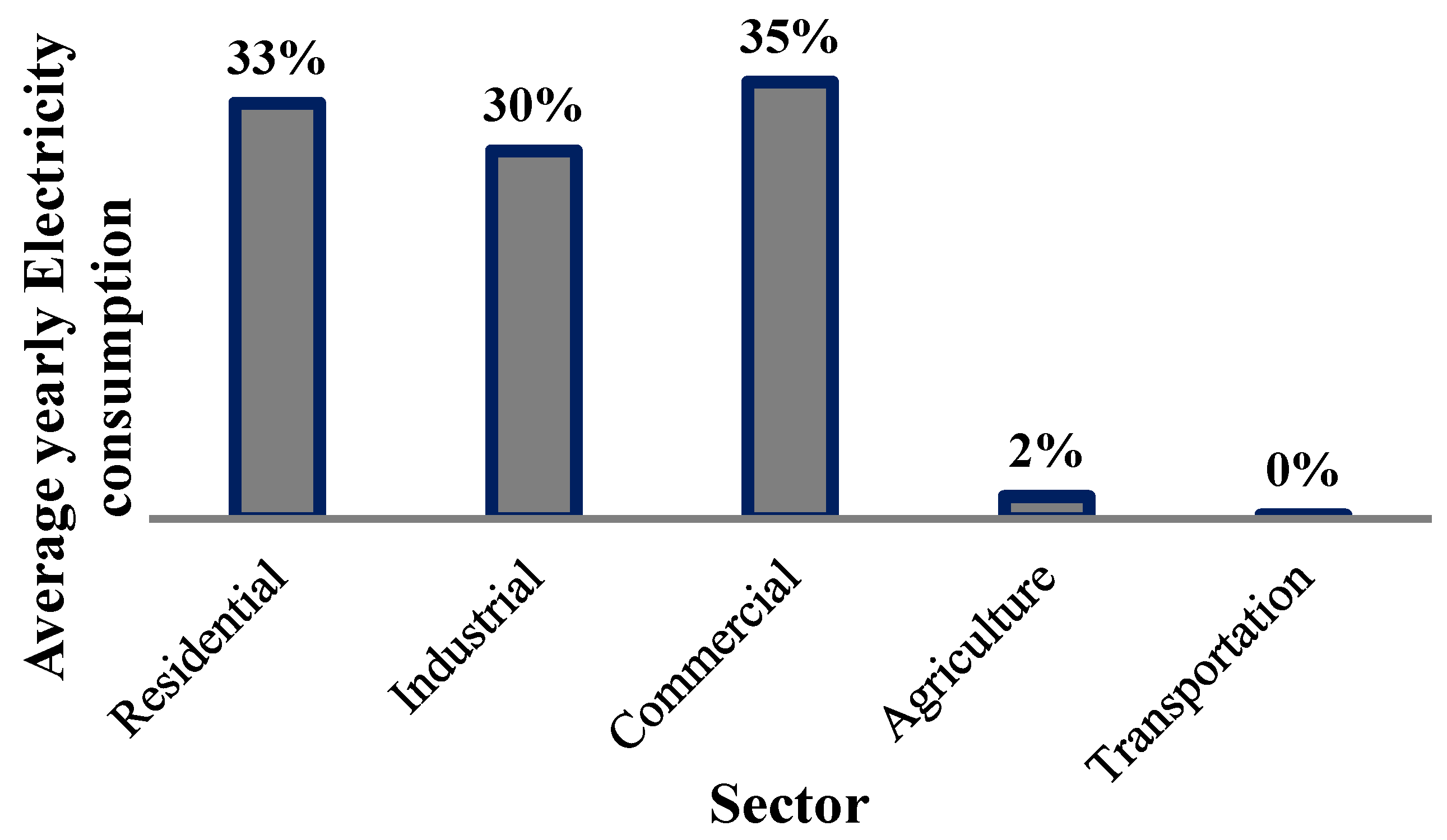

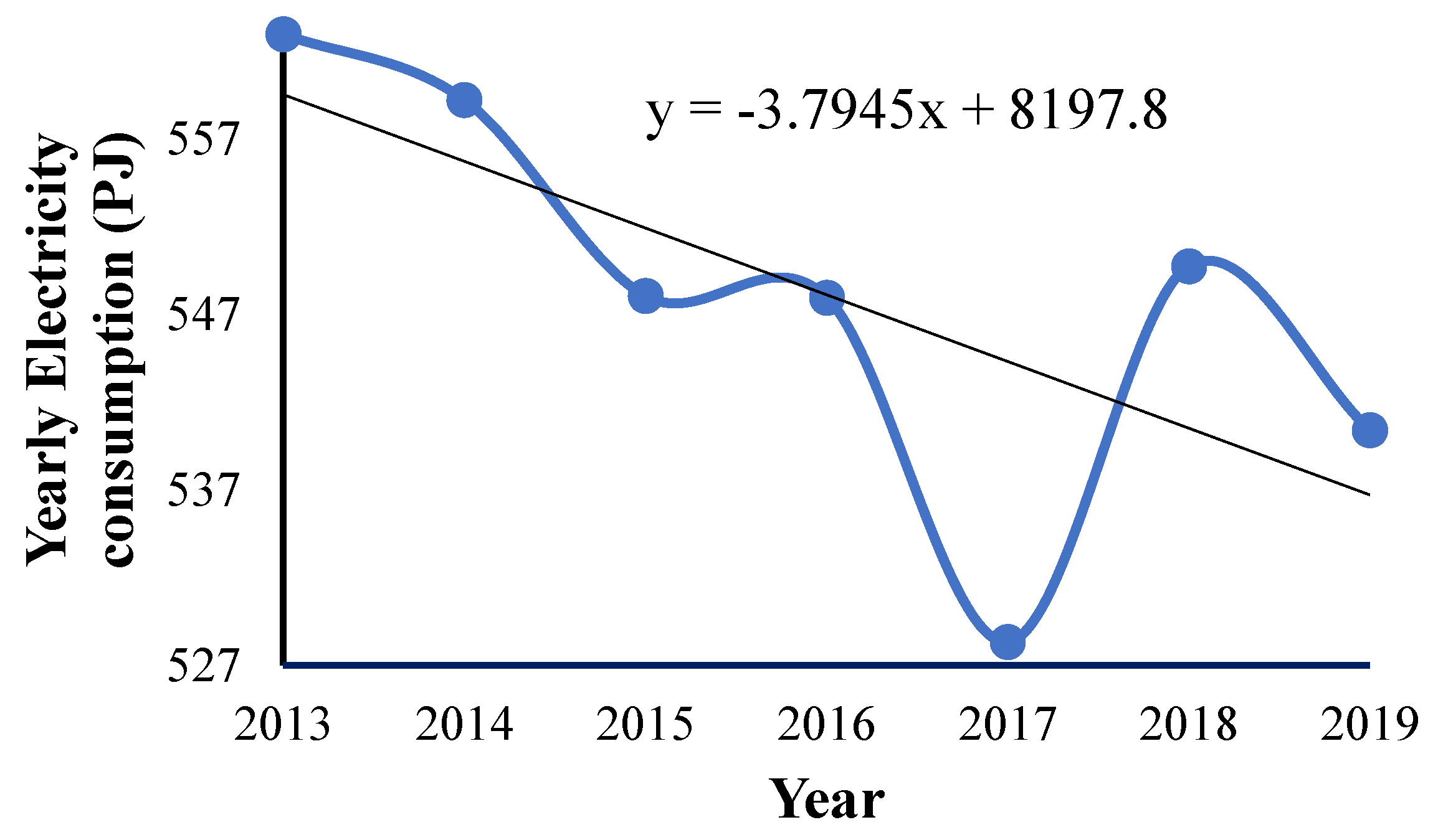
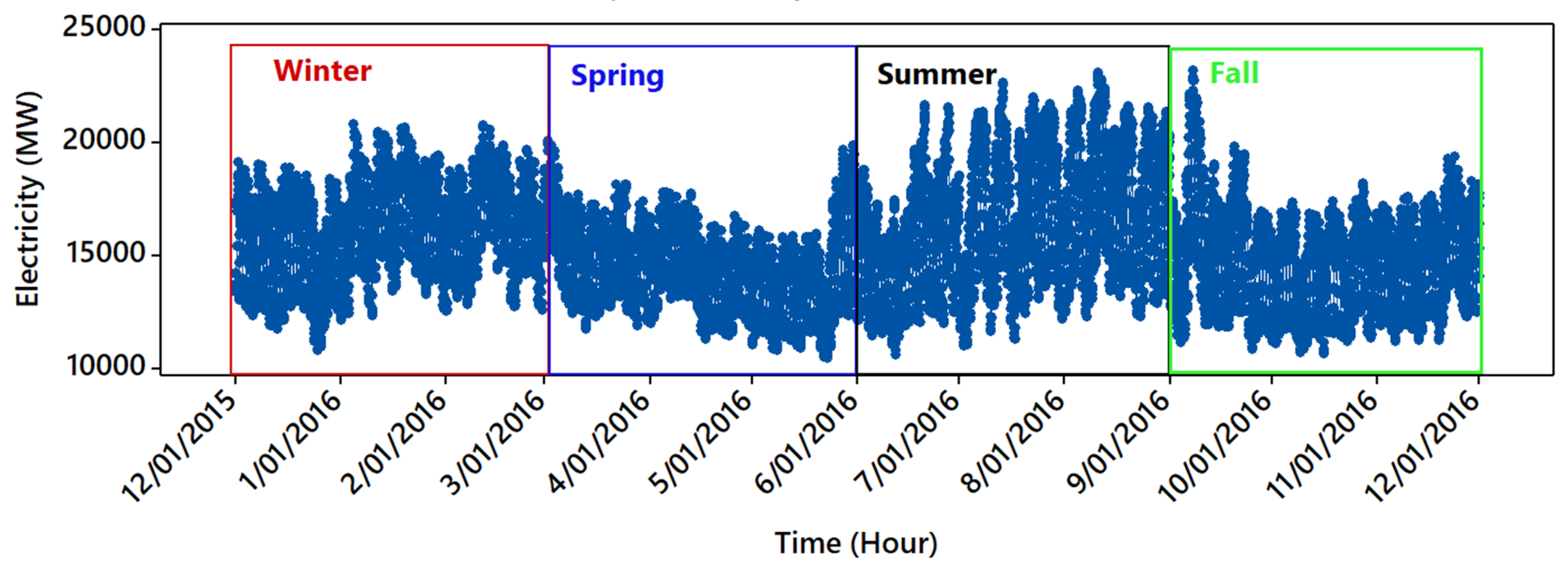

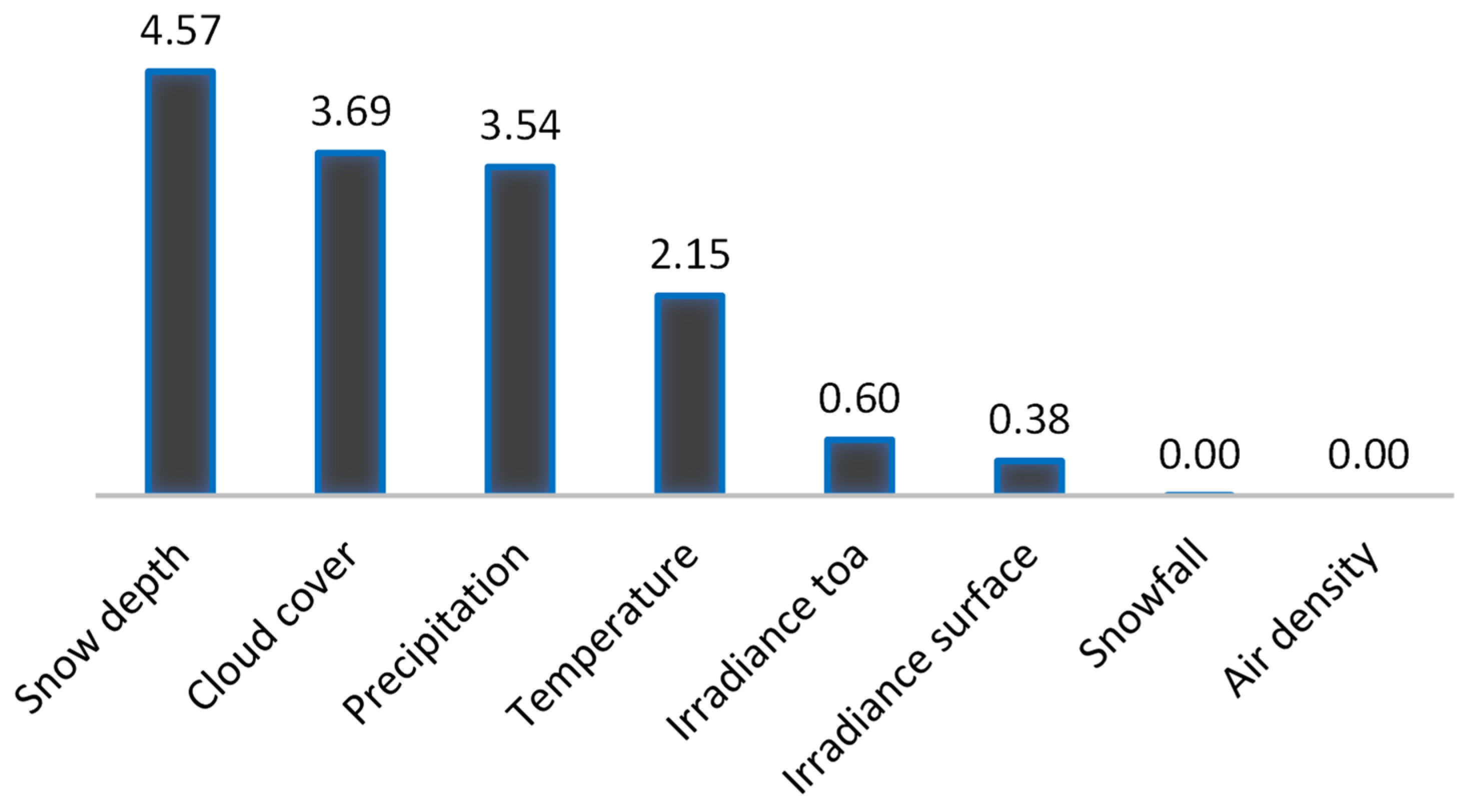
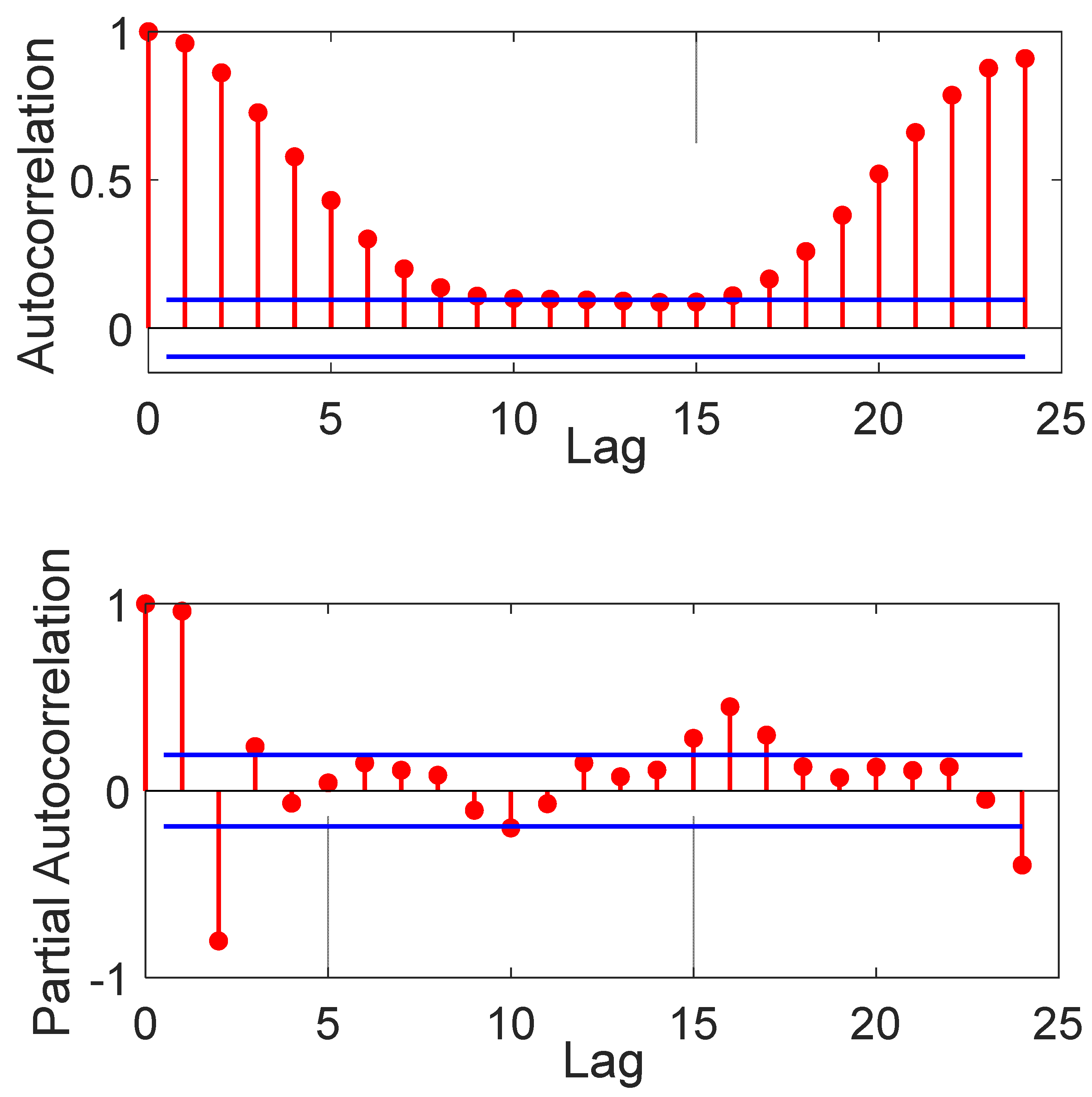

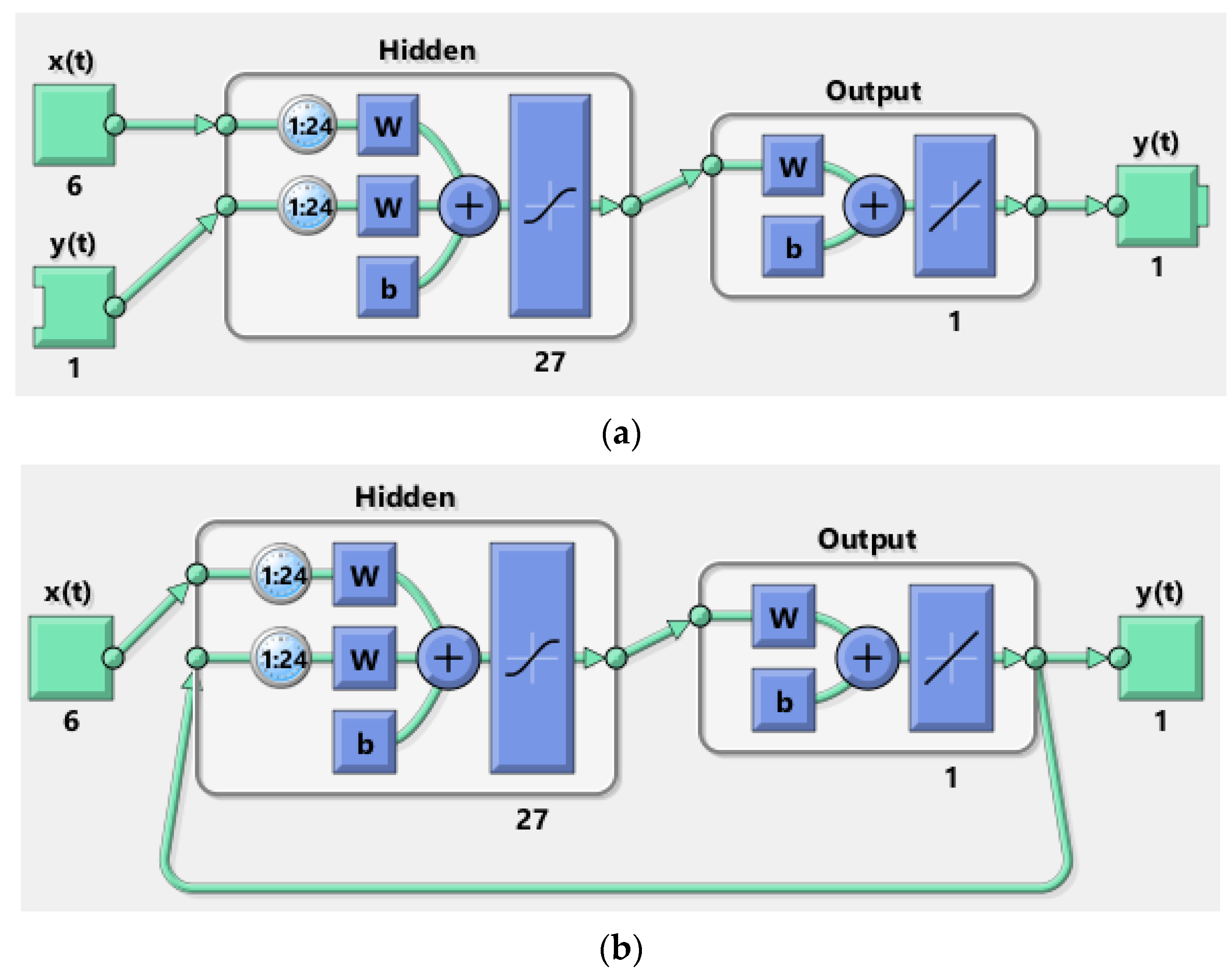

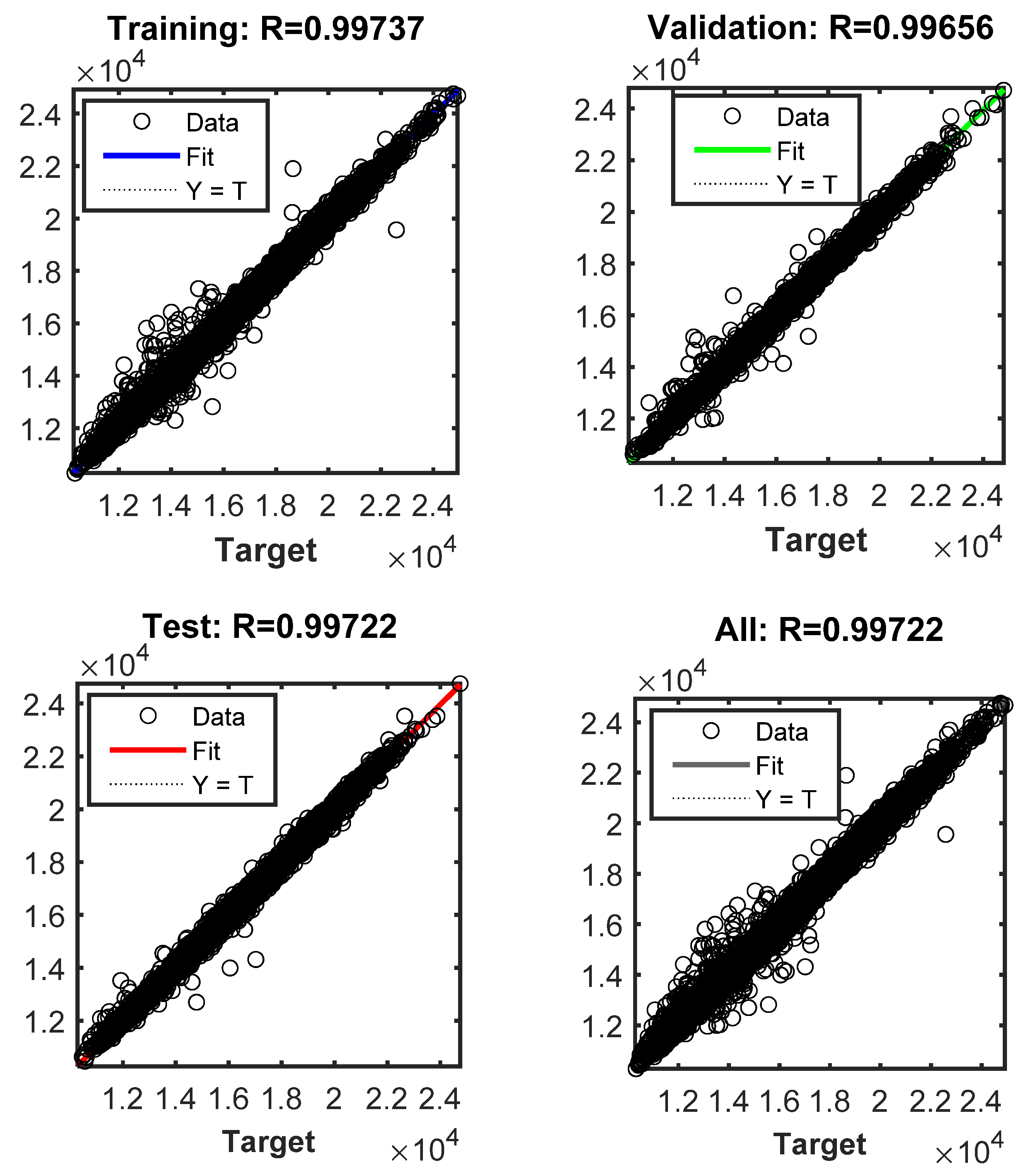
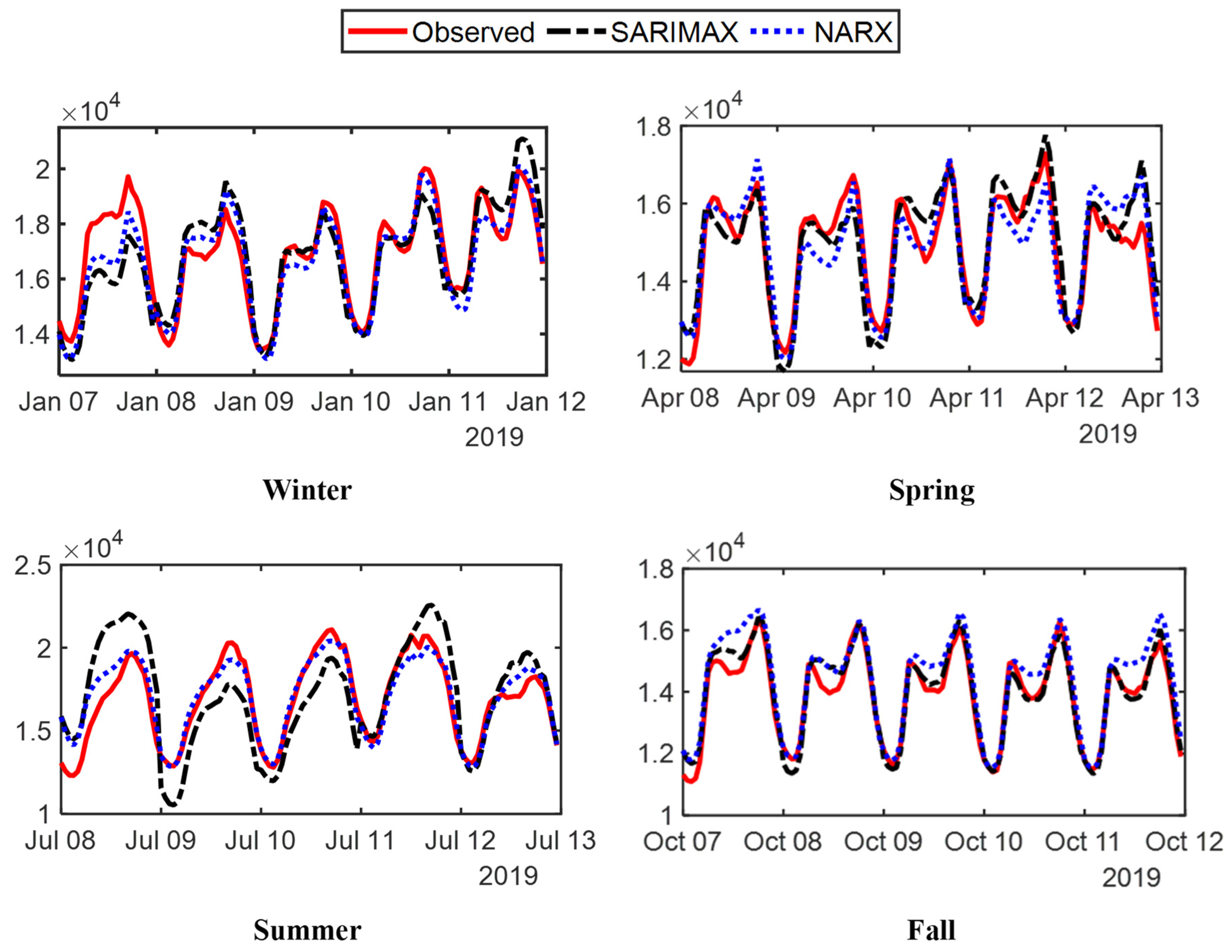
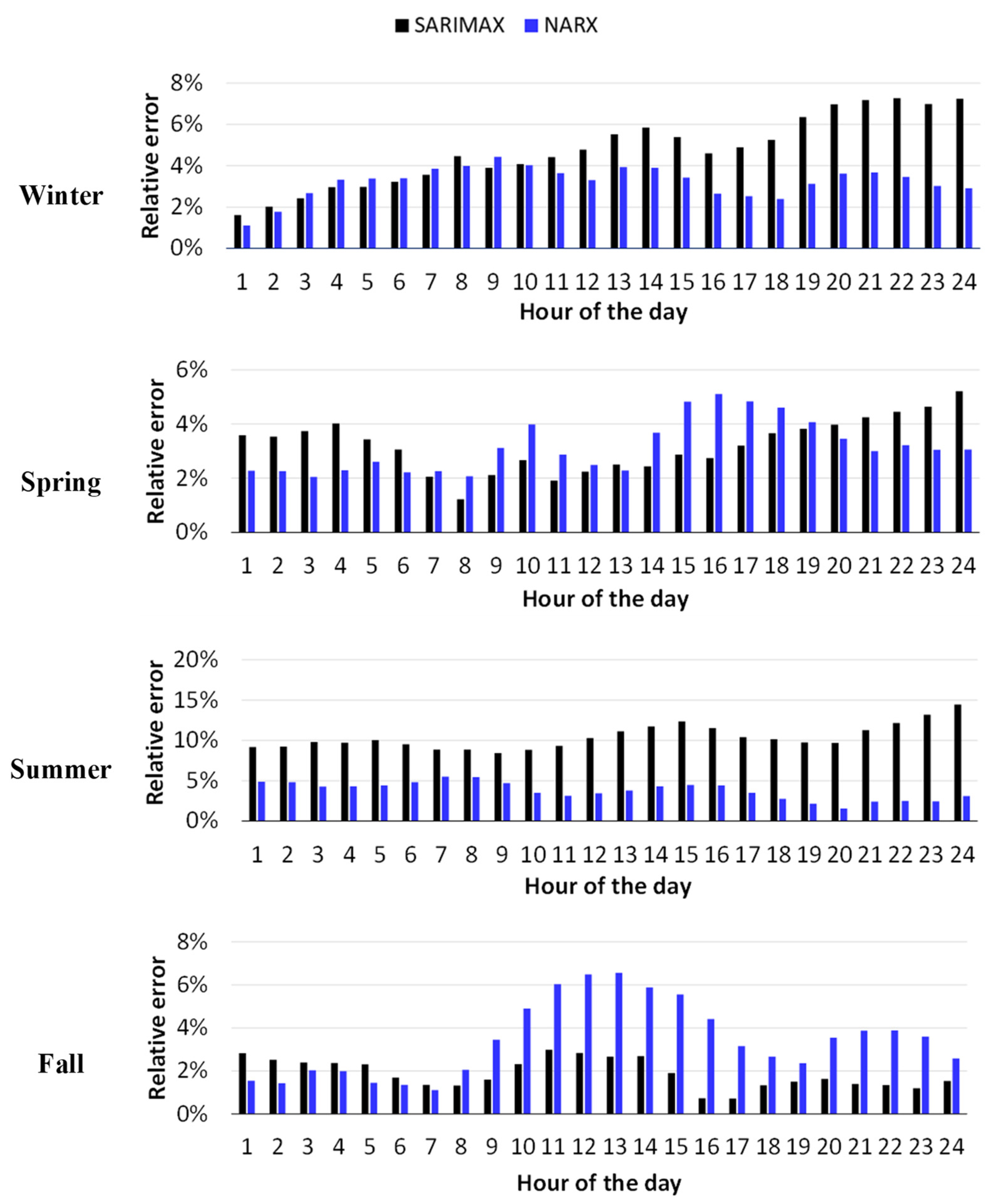
| Acronym | Description | Acronym | Description |
|---|---|---|---|
| ABCNN | Artificial Bee Colony-based ANN model | LSTM-RNN | LSTM-based Recurrent Neural Networks |
| ACF | Autocorrelation function | NARX | Nonlinear autoregressive networks with exogenous input |
| ACS | Artificial cooperative search | MA | moving average |
| AE | Absolute error | MAE | Mean absolute error |
| AIM | Abductory Induction Mechanism | MAPE | Mean Absolute Percentage Error |
| ANN | Artificial Neural Network | MARS | Multivariate Adaptive Regression Spline |
| ANN ABC | Artificial neural network with artificial bee colony algorithm | ML | Machine learning |
| ANN BP | ANN with backpropagation | MLP | Feedforward multilayer perceptron structure |
| ANN TLBO | ANN with Teaching Learning Based Optimization | MLR | Multiple linear regression |
| APSONN | Artificial Particle Swarm Optimization based ANN | MODWT | Maximum overlap discrete wavelet transform |
| AR | Autoregressive | MPOE | MODWT-PACF-OS-ELM |
| ARIMA | Autoregressive integrated moving average | MSE | Mean square error |
| ARMAX | Autoregressive moving average | MWh | Megawatt-hours |
| BOA | Bayesian optimization algorithm | NRCan | Natural Resources Canada |
| CER | Canada Energy Regulator | OPEC | Organization of Petroleum Exporting Countries |
| CS | Cuckoo Search algorithm | OS-ELM | Online sequential extreme learning machine |
| CSNN | Cuckoo Search Algorithm utilizing Lévy flights associated with ANN | PACF | Partial autocorrelation function |
| CVRMSE | Coefficient of variation RMSE | Pj | Yearly electricity load |
| DE | Differential Evolution | POE | PACF-OS-ELM |
| ELM | Legates and McCabe’s Index | PSO | Particle-swarm optimization |
| EMD | Empirical Mode Decomposition | QQ plot | Quantile–quantile plot |
| ENS | Nash–Sutcliffe efficiency coefficient | R2 | Coefficient of Determination |
| FB | Fractional Bias | R2 (adj) | Adjusted Coefficient of Determination |
| GA | Genetic algorithm | RE | Relative error |
| GANN | Genetic Algorithm based ANN | RF | Random Forest |
| GB | Gradient Boosting | RRMSE | Relative Root Mean Square Error |
| GP | Gaussian process | RMSE | Root Mean Square Error |
| HDIP | Hydrocarbon Development Institute of Pakistan | RNN | Recurrent Neural Network |
| ICA | Independent Component Analysis | SARIMAX | Seasonal autoregressive integrated moving average with exogenous inputs |
| KNN | K-Nearest Neighbor | SA | Simulated Annealing |
| LEAP | Long-range Energy Alternative Planning | SVR | Support Vector Machine |
| LR | Linear Regression | WI | Willmott’s Index |
| LSTM | Long–short-term memory |
| Refs. | Region | Extra Information | Method | Hyperparameters Tuning | Benchmarked Methods | Metrics | Performance |
|---|---|---|---|---|---|---|---|
| [21] | Iran | Socio-economic indicator | ACS | Linear, quadratic, exponential, and logarithmic mathematic models | GA, PSO, ICA, CS, SA, DE | AE, RMSE, U-statistic, MAPE | ACS achieved high performance with the lowest errors measured |
| [22] | Pakistan | ARIMA | Holt-Winter | RMSE, MAPE | ARIMA confidence interval of 95% compared with other models | ||
| [23] | Turkey | GDP, population, import, and export | ANN-TLBO | ANN-BP, ANN-ABC | RMSE, Time | RMSE reduced by 42.3% and 39.3% | |
| [24] | 12 OPEC countries | CSNN | APSONN, GANN, ABCNN | MSE | CSNN achieved the best performance | ||
| [25] | Turkey | MAPE | 0.87%, 2.90%, and 3.54% in the hourly, daily, and yearly forecasts | ||||
| [15] | France | Time lags, temperature, humidity, wind speed | LSTM-RNN | GA | LR, Ridge regression, KNN, RF, GB, ANN, Extra tree regressors | RMSE | Variation of 0.61% |
| [26] | Chandirgah/India | Hybrid LSTM and EMD | RNN, LSTM. EMD + RNN | RMSE, MAPE | Better accuracy + 5 to 8% | ||
| [27] | Southeast Queensland, Australia | Maximum temperature, minimum temperature, rainfall, evaporation, solar radiation, and vapor pressure | Hybrid ANN + MARS + MLR | ANN, MLR, MARS, ARIMA | ELM, WI, ENS, MAE, RMSE, MAPE, RRMSE | RMSE of 3.85% for the 6 h forecasting and 4.37% for daily forecasting | |
| [30] | Queensland, Australia | MARS | ARIMA, SVR | r, RMSE, MAE | MAE values of 0.765 and 1.446, respectively | ||
| [28] | Thailand | Temperature and other deterministic features on Thai electricity demand | Feedforward artificial neural network | ordinary least square and general least square | Regression had better accuracy | ||
| [32] | Eastern province of Saudi Arabia | Weather parameters and demographic and economic variables | ARIMA (univariate Box-Jenkins time-series analysis) | AIM, multivariate regression | Average percentage error | Average percentage error of 3.8% compared to 8.1% and 5.6% | |
| [33] | Abu Dhabi, UAE | Dry bulb temperature as a variable that affected the electricity load | SARIMAX | ANN | RMSE, MAPE | SARIMAX outperformed ANN with RMSE of 62.61 MW (vs. 72.92 MW), MAPE 2.98% (vs. 3.57%) | |
| [34] | Two university buildings in Canada | Daily average temperature and the humidity | SARIMAX | MAPE | 4.1% and 12.8% | ||
| [35] | New England electric grid | Wet bulb temperature and dry bulb temperature) | NARX | ARMAX | MAPE | NARX MAPE = 0.85% vs. ARMAX MAPE = 1.09% | |
| [36] | Three campuses in the University of Southern Queensland, Australia | MPOE | POE | MAPE | 4.31% | ||
| This study | Ontario, Canada | Precipitation, snowfall, snow mass, air density, ground-level solar irradiation, top of atmosphere solar irradiation, cloud cover fraction | NARX | BOA | SARIMAX | MAE, RMSE, MAPE, R2, RE, time | BOA-NARX MAPE ~3%, steady RE 1~6.56%) |
| Model | ||||||||
|---|---|---|---|---|---|---|---|---|
| SARIMAX | Parameters | |||||||
| Range for BOA | [1, 24] | [1, 24] | [0, 2] | [1, 2] | [1, 2] | [0, 2] | - | |
| Optimized value | 24 | 14 | 0 | 2 | 2 | 1 | 24 | |
| NARX | Parameters | No. of Hidden layers | Hidden layer size | Input delay | Feedback delay | Training function | Training error | |
| Range for BOA | - | [1, 50] | [1, 24] | [1, 24] | - | - | ||
| Optimized value | 1 | 27 | 24 | 24 | Levenberg–Marquardt | MSE |
| MAE (MW) | RMSE (MW) | MAPE (MW) | FB | ||||
|---|---|---|---|---|---|---|---|
| BOA-SARIMAX | January 2019 | 825.1307 | 945.8183 | 4.7468 | 0.9719 | 0.9641 | 0.0101 |
| April 2019 | 469.5054 | 573.8192 | 3.2249 | 0.9499 | 0.9360 | −0.0059 | |
| July 2019 | 1735.5 | 1910 | 10.4028 | 0.9635 | 0.9534 | −0.0058 | |
| October 2019 | 256.5279 | 303.7495 | 1.8782 | 0.9869 | 0.9833 | −0.0059 | |
| BOA-NARX | January 2019 | 553.0839 | 614.9764 | 3.2299 | 0.9687 | 0.9600 | 0.0168 |
| April 2019 | 471.7548 | 555.9796 | 3.1555 | 0.9512 | 0.9377 | 0.0005 | |
| July 2019 | 610.4919 | 719.0792 | 3.7649 | 0.9674 | 0.9584 | −0.0112 | |
| October 2019 | 480.9545 | 570.1857 | 3.4114 | 0.96179 | 0.9512 | −0.0325 |
| BOA-SARIMAX | BOA-NARX | |||||
|---|---|---|---|---|---|---|
| Percentage of Introduced Noise | MAE | RMSE | MAPE | MAE | RMSE | MAPE |
| 0% | 825.1307 | 945.8183 | 4.7468 | 553.0839 | 614.9764 | 3.2299 |
| 20% | 825.1293 | 945.8161 | 4.7468 | 553.3542 | 615.2964 | 3.2314 |
| 40% | 825.2115 | 945.9330 | 4.7473 | 554.3769 | 616.0434 | 3.2371 |
| 60% | 825.4104 | 946.3487 | 4.7482 | 562.3439 | 620.1726 | 3.2773 |
Publisher’s Note: MDPI stays neutral with regard to jurisdictional claims in published maps and institutional affiliations. |
© 2022 by the authors. Licensee MDPI, Basel, Switzerland. This article is an open access article distributed under the terms and conditions of the Creative Commons Attribution (CC BY) license (https://creativecommons.org/licenses/by/4.0/).
Share and Cite
Sultana, N.; Hossain, S.M.Z.; Almuhaini, S.H.; Düştegör, D. Bayesian Optimization Algorithm-Based Statistical and Machine Learning Approaches for Forecasting Short-Term Electricity Demand. Energies 2022, 15, 3425. https://doi.org/10.3390/en15093425
Sultana N, Hossain SMZ, Almuhaini SH, Düştegör D. Bayesian Optimization Algorithm-Based Statistical and Machine Learning Approaches for Forecasting Short-Term Electricity Demand. Energies. 2022; 15(9):3425. https://doi.org/10.3390/en15093425
Chicago/Turabian StyleSultana, Nahid, S. M. Zakir Hossain, Salma Hamad Almuhaini, and Dilek Düştegör. 2022. "Bayesian Optimization Algorithm-Based Statistical and Machine Learning Approaches for Forecasting Short-Term Electricity Demand" Energies 15, no. 9: 3425. https://doi.org/10.3390/en15093425
APA StyleSultana, N., Hossain, S. M. Z., Almuhaini, S. H., & Düştegör, D. (2022). Bayesian Optimization Algorithm-Based Statistical and Machine Learning Approaches for Forecasting Short-Term Electricity Demand. Energies, 15(9), 3425. https://doi.org/10.3390/en15093425








